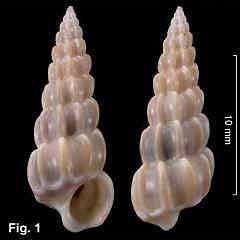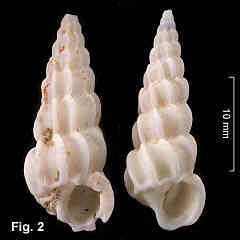|
|
|
|
|
Page not in use. Has a space at end of page name.
Opalia australis (Lamarck, 1822) Description: Shell tall, variable in height to width ratio (Fig. 2). Whorls rounded, sculptured with strong axial ribs, aligned from whorl to whorl. Ribs 8-11 on last whorl; interspaces smooth or with faint spiral threads. Axial ribs end at strong spiral rib on base. Umbilicus closed. Aperture oval, outer lip with varix externally, expanded anteriorly. Colour uniformly white internally and externally. Operculum corneous. Size: Up to 34 mm in length, commonly 20 mm. Distribution: Endemic to Australia; Iluka, NSW, around southern Australia to Perth, WA. Habitat: Under rocks on rocky shores in association with anemones, low intertidal and shall subtidal. Moderately common. Comparison: This species is relatively large, solid and heavy, and is the one most commonly found in beach washup. See also O. ballinensis. Synonymy: The name Opalia consors (Crosse & Fischer, 1864), a name used in South Australia, probably refers to this species. Remarks: B.J. Smith, Black & Shepherd (1989) described the egg capsules of this species. Eggs are contained in sand-encrusted spherical capsules of about 1.8 mm in diameter, joined by thin, delicate threads about the same length as the capsule diameter. Each capsule contains over 100 eggs. The intritacalx (a chalky shell surface layer present in shells of the genus Opalia) is thick and relatively hard in shells of this species. Without magnification the intritacalx surface appears smooth or with weak spiral threads, but at 50x magnification a rectangular pattern of minute pits is visible. Fig. 1: Boat Harbour, Cronulla, NSW (C.339778) Fig. 2: Woolgoolga, NSW (C.339408) |

